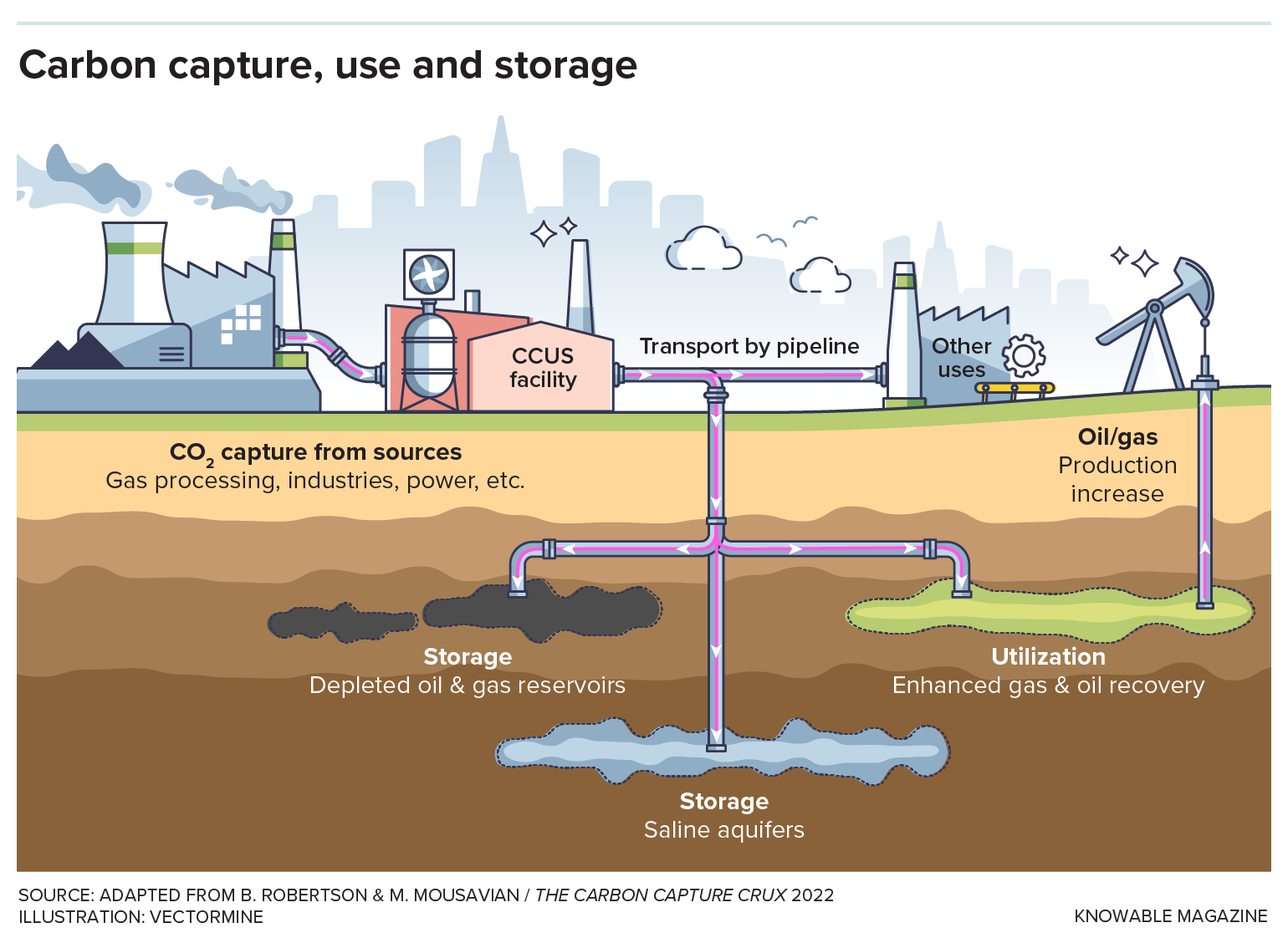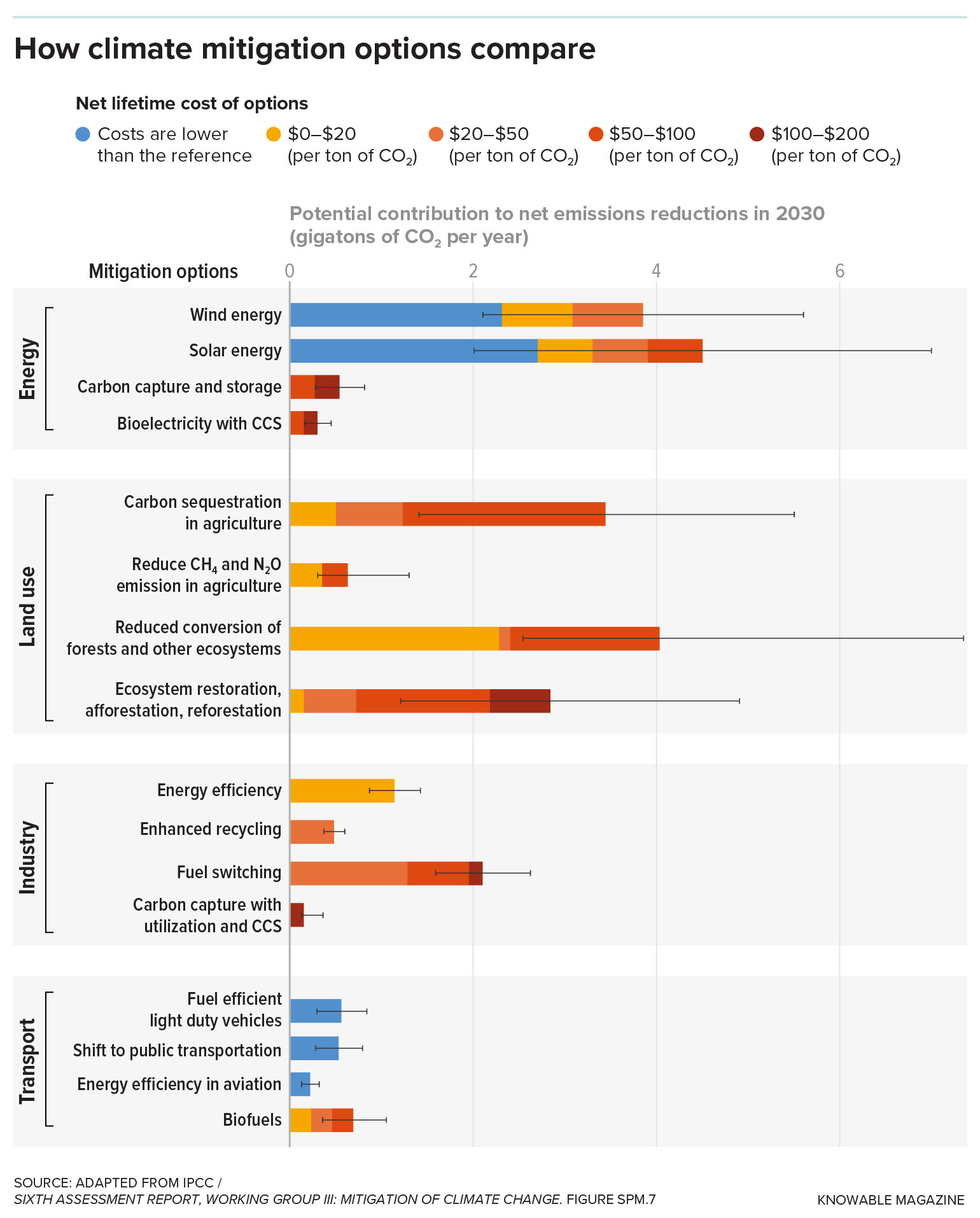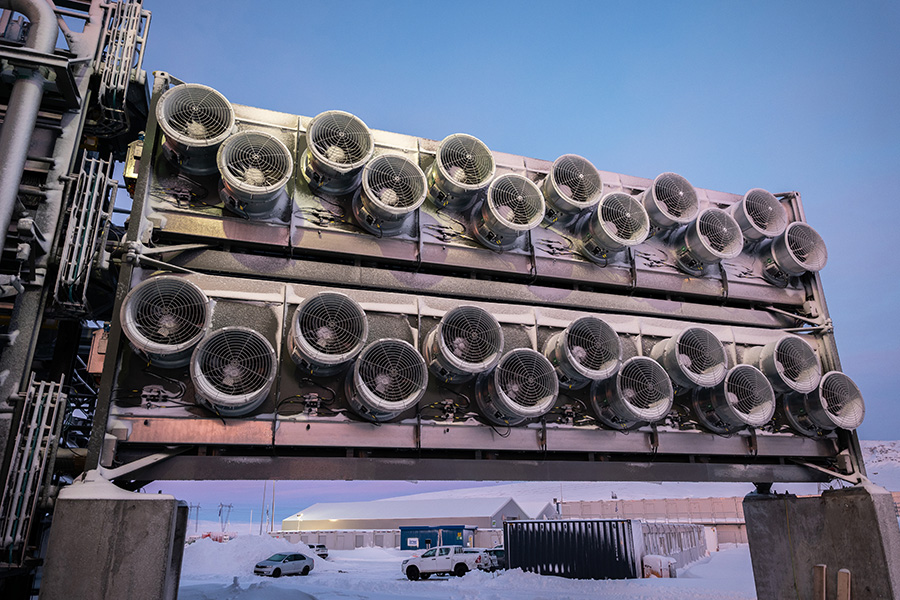To help with climate change, carbon capture will have to evolve
The technologies are a useful tool to reduce CO2 levels but have yet to move us away from fossil fuels
Support sound science and smart stories
Help us make scientific knowledge accessible to all
Donate today
More than 200 kilometers off Norway’s coast in the North Sea sits the world’s first offshore carbon-capture-and-storage project. Built in 1996, the Sleipner project strips carbon dioxide from natural gas — largely made up of methane — to make it marketable. But instead of releasing the CO2 into the atmosphere, the greenhouse gas is buried.
The effort stores around 1 million metric tons of CO2 per year — and is praised by many as a pioneering success in global attempts to cut greenhouse gas emissions.
Last year, total global CO2 emissions hit an all-time high of around 35.8 billion tons, or gigatons. At these levels, scientists estimate, we have roughly six years left before we emit so much CO2 that global warming will consistently exceed 1.5 degrees Celsius above average preindustrial temperatures, an internationally agreed-upon limit. (Notably, the global average temperature for the past 12 months has exceeded this threshold.)
Phasing out fossil fuels is key to cutting emissions and fighting climate change. But a suite of technologies collectively known as carbon capture, utilization and storage, or CCUS, are among the tools available to help meet global targets to cut CO2 emissions in half by 2030 and to reach net-zero emissions by 2050. These technologies capture, use or store away CO2 emitted by power generation or industrial processes, or suck it directly out of the air. The Intergovernmental Panel on Climate Change (IPCC), the United Nations body charged with assessing climate change science, includes carbon capture and storage among the actions needed to slash emissions and meet temperature targets.

Carbon capture, utilization and storage technologies often capture CO2 from coal or natural gas power generation or industrial processes, such as steel manufacturing. The CO2 is compressed into a liquid under high pressure and transported through pipelines to sites where it may be stored, in porous sedimentary rock formations containing saltwater, for example, or used for other purposes. The captured CO2 can be injected into the ground to extract oil dregs or used to produce cement and other products.
Governments and industry are betting big on such projects. Last year, for example, the British government announced £20 billion (more than $25 billion) in funding for CCUS, often shortened to CCS. The United States allocated more than $5 billion between 2011 and 2023 and committed an additional $8.2 billion from 2022 to 2026. Globally, public funding for CCUS projects rose to $20 billion in 2023, according to the International Energy Agency (IEA), which works with countries around the world to forge energy policy.
Given the urgency of the situation, many people argue that CCUS is necessary to move society toward climate goals. But critics don’t see the technology, in its current form, shifting the world away from oil and gas: In a lot of cases, they point out, the captured CO2 is used to extract more fossil fuels in a process known as enhanced oil recovery. They contend that other existing solutions such as renewable energy offer deeper and quicker CO2 emissions cuts. “It’s better not to emit in the first place,” says Grant Hauber, an energy finance adviser at the Institute for Energy Economics and Financial Analysis, a nonpartisan organization in Lakewood, Ohio.
What’s more, fossil fuel companies provide funds to universities and researchers — which some say could shape what is studied and what is not, even if the work of individual scientists is legitimate. For these reasons, some critics say CCUS shouldn’t be pursued at all.
“Carbon capture and storage essentially perpetuates fossil fuel reliance. It’s a distraction and a delay tactic,” says Jennie Stephens, a climate justice researcher at Northeastern University in Boston. She adds that there is little focus on understanding the psychological, social, economic and political barriers that prevent communities from shifting away from fossil fuels and forging solutions to those obstacles.
According to the Global CCS Institute, an industry-led think tank headquartered in Melbourne, Australia, of the 41 commercial projects operational as of July 2023, most were part of efforts that produce, extract or burn fossil fuels, such as coal- and gas-fired power plants. That’s true of the Sleipner project, run by the energy company Equinor. It’s the case, too, with the world’s largest CCUS facility, operated by ExxonMobil in Wyoming, in the United States, which also captures CO2 as part of the production of methane.
Granted, not all CCUS efforts further fossil fuel production, and many projects now in the works have the sole goal of capturing and locking up CO2. Still, some critics doubt whether these greener approaches could ever lock away enough CO2 to meaningfully contribute to climate mitigation, and they are concerned about the costs.
Others are more circumspect. Sally Benson, an energy researcher at Stanford University, doesn’t want to see CCUS used as an excuse to carry on with fossil fuels. But she says the technology is essential for capturing some of the CO2 from fossil fuel production and usage, as well as from industrial processes, as society transitions to new energy sources. “If we can get rid of those emissions with carbon capture and sequestration, that sounds like success to me,” says Benson, who codirects an institute that receives funding from fossil fuel companies.

Annual global carbon dioxide emissions need to be cut in half by 2030, or by about 20 gigatons, to achieve net-zero emissions by 2050. Carbon capture, utilization and storage technologies, called CCUS or CCS, are estimated to contribute less to emissions reductions than some other climate mitigation strategies, including shifting to renewable energy or restoring ecosystems. CCUS can also be more expensive; costs here are expressed as additional costs relative to the existing technology or status quo effort.
Born from the oil industry
CCUS technology was not conceived as a climate solution. It dates to the 1970s and 1980s, when oil production in the United States began to decline. Oil companies started using a process called enhanced oil recovery that injects CO2 (or water) into sedimentary rocks to recover hard-to-reach dregs of oil, a precursor to today’s CCUS.
CCUS technologies are now capturing CO2 from a variety of operations — including at traditional power plants that burn coal or other fossil fuels; in nontraditional plants where energy is produced from biofuels such as ethanol; and during the production of ammonia, which is used in fertilizer. All such efforts complement other practices that turn to natural processes to remove carbon from the atmosphere to help reach net zero, such as planting forests or locking CO2 in soils using sustainable farming practices.
The strongest criticisms are lobbed at using CCUS to extract fossil fuels. Today nearly three-quarters of the carbon captured through CCUS projects is used to extract more oil from dregs. The largest CCUS operation, ExxonMobil’s $656 million Shute Creek facility in Wyoming, aims to capture around 8 million tons of CO2 each year from methane extracted from the nearby LaBarge gas fields. ExxonMobil sells the captured CO2 for enhanced oil recovery. Though the effort cuts emissions because some of the CO2 remains in the ground, the burning of the additional fossil fuels it helps extract still releases CO2.
Just 12 of the 41 existing projects included in the Global CCS Institute database inject CO2 with the exclusive aim of storing it underground, thus keeping its climate-warming effects at bay. Half of those 12, including the Sleipner project, are involved in methane production — and methane releases carbon dioxide into the atmosphere when burned.
Cement manufacturing and iron and steel manufacturing are also desirable targets for CCUS, because each produces around 6 percent to 9 percent of global CO2 emissions, and both processes are difficult to clean up in other ways. Only one project, run by the Abu Dhabi National Oil Company, is capturing CO2 emissions from iron and steelmaking. There are no projects up and running to capture CO2 from cement manufacturing.
The Global CCS Institute’s database includes just a single fully operational, large-scale project that is currently sucking CO2 directly from the air and storing it underground. That project, in Hellisheiði, Iceland, is run by the Swiss company Climeworks. Another, bigger Climeworks project recently started operations but is not yet completed.
But the database omits direct air capture projects that are doing other things with the CO2, including one that is sealing it in concrete, and omits smaller-scale and pilot projects that are online or coming online.
A decade ago in a paper in the Annual Review of Environment and Resources, Benson and Heleen de Coninck, a climate change researcher at the Eindhoven University of Technology and Radboud University in the Netherlands, wrote that, to help mitigate climate change, CCUS needs to serve more than fossil fuel companies seeking to extract oil. In the decade since, Benson notes, CCUS has been slow to expand into other areas largely because of a lack of public policies supporting the technologies, such as government subsidies for new projects or a tax on CO2 emissions that would make it cheaper to sequester than to emit it. However, she notes, this is now changing.

When it is fully operational, Climeworks’ Mammoth project will be the world’s largest facility pulling CO2 directly from the air and burying it underground. The project, in Hellisheiði, Iceland, follows another, smaller Climeworks project called Orca.
CREDIT: © 2024 CLIMEWORKS AG
Looking to the future
CCUS may be poised to turn a corner. As of July 2023, 351 new commercial-scale CCUS projects were in the works, according to the Global CCS Institute. Many of these forthcoming projects will capture CO2 with the exclusive goal of burying it underground rather than using it to squeeze out more oil. Around 22 of the projects are aimed at capturing CO2 at cement plants and five will capture CO2 directly from the air and store it underground. Still, a connection with fossil fuels remains: Around 30 will serve methane production, and others are planned for carbon capture at coal- and gas-fired power plants.
Even with this new bloom of projects, it’s not clear that the technology has a large part to play in solving our climate woes, says Sean O’Leary, a senior researcher in energy and economics at the Ohio River Valley Institute, a clean-energy think tank based in Johnstown, Pennsylvania.
Current and future projects are unlikely to capture carbon in sufficient quantities to make much of a dent on global emissions, O’Leary says. Estimates suggest that existing projects could capture around 50 million tons of CO2 annually — cutting the more than 35 billion tons of gross global carbon emissions by around 0.14 percent. Once all 392 projects are online, they could capture a few hundred million tons — about 1 percent of carbon emissions. Estimates of how much carbon CCUS needs to capture to help achieve climate goals vary widely between 1 billion and 30 billion tons annually by 2050.

Large-scale CCUS projects currently online or in development are expected to capture more than 400 megatons of CO2 per year by 2030. That’s far short of the more than 1 gigaton of CO2 per year CCUS projects would need to capture by then in order to stay on track with the International Energy Agency’s scenario for achieving net-zero emissions by 2050.
A recent analysis suggests that at least 5 billion tons annually is achievable. The research, not yet published, limits CCUS growth to an average of 20 percent per year until 2050 for most cases. “That’s a major contribution to climate mitigation,” says Samuel Krevor, an environmental engineer at Imperial College London and a lead author of the research. Krevor, like many researchers in the field, receives some funding from fossil fuel companies.
But Hauber says the contribution is likely to be minor relative to other climate solutions, including shifting to renewable energy and planting and maintaining forests to help store away CO2 from the atmosphere. Using data from the IPCC, Hauber and colleagues calculate that by 2030, CCUS will provide just 2.4 percent of all emissions reductions.
What’s more, projects rarely meet their stated goals. An analysis by the Institute for Energy Economics and Financial Analysis of 13 key CCUS projects, published in 2022, found that most failed to reach their targets. Relying on publicly available data, the analysis found, for example, that the Shute Creek facility has underperformed by 36 percent over its lifetime. When there were fewer customers for the captured CO2, the analysis finds, the facility released it into the atmosphere. A facility in Decatur, Illinois, run by Archer Daniels Midland, an agribusiness based in Chicago, was nearly 50 percent off its annual target at the end of 2020.
An ExxonMobil spokesperson said the company has made progress since the report, noting that the company has expanded CO2 storage capacity at its Shute Creek facility by over 1 million metric tons annually. And a spokesperson for Archer Daniels Midland said that how much CO2 it captures and stores depends on how much biofuel it produces. The company’s Decatur facility is looking at different strategies to decarbonize its operations including capturing CO2 produced by a new gas power plant that will provide energy for the company’s biofuel facility.
It’s also unclear how much CO2 capacity underground storage sites possess. Most global estimates suggest that between 10,000 billion and 30,000 billion tons of underground storage is available. Some estimates put it as a high as 55,000 billion tons. But Chris Greig, a chemical engineer at Princeton University who previously worked on a CCUS project for the fossil fuel industry, notes that those volumes could be way off. Assessments are based on estimates of the pore space in different geologic formations — those pores provide open spaces that can hold CO2 — which gives only a rough picture, he says: “Subsurface storage is by nature uncertain.”
Such uncertainties have caused projects to veer off course, including a $2.7 billion project to separate CO2 from methane in gas fields in In Salah, Algeria, and store it 1.9 kilometers underground. The energy company Equinor and its partners started injecting CO2 there in 2004 with the aim of storing 1.1 million tons annually. But it suspended operations because of limits in underground capacity, according to an Equinor spokesperson. There were concerns that the gas was escaping up toward the cap rock, which acts as a final safety net sealing the CO2 in place.
On top of the uncertainty, money is a problem. Some skeptics say that the costs of building and operating CCUS projects ultimately make them unviable. According to 2019 data from the IEA, the costs of capturing CO2 range from $15 to $120 per ton, depending on how dilute the gas stream is. Cost estimates for capturing CO2 directly from the air, where it is very dilute, typically vary between $225 and $500 per ton, with some estimates as high as $1,000 per ton. Multiply that price tag by even a small portion of the 1 billion tons of CO2 that the IPCC says needs to be removed from the atmosphere by 2050, and the costs quickly add up.
Some experts point out that these costs will likely go down as the technologies mature and if the market increases, though not necessarily on the same scale as the dramatic costs reductions seen for solar and wind power technology. For example, the IEA notes that costs for CO2 capture from coal-fired power plants dropped from over $100 per ton in 2014 to $65 per ton in 2017, and it estimates that in projects built from 2025 to 2027, the cost will be around $45 per ton.
Partly because of the costs, CCUS should be prioritized for cases where there are no other reasonable approaches to reducing CO2 emissions, says Sabine Fuss, a climate economist at the Mercator Research Institute on Global Commons and Climate Change and at Humboldt University of Berlin. She does, though, see a potential role for direct air capture despite its expense. And while researchers are divided on the feasibility of direct air capture, Fuss thinks it needs to be funded regardless. If the world overshoots its climate targets, she says, we will likely need this technology to reach net-zero emissions and forestall even worse effects of climate change.
How big a role CCUS will eventually need to play is up to us and what we do now, Fuss says. But given the uncertainties, we can’t continue to burn fossil fuels and release carbon and count on CCUS to clean it up afterward. “We have to do all that we can to reduce emissions in the short to medium term rather than rely on CO2 removals in the longer run,” she says.
10.1146/knowable-070924-2
TAKE A DEEPER DIVE | Explore Related Scholarly Articles






